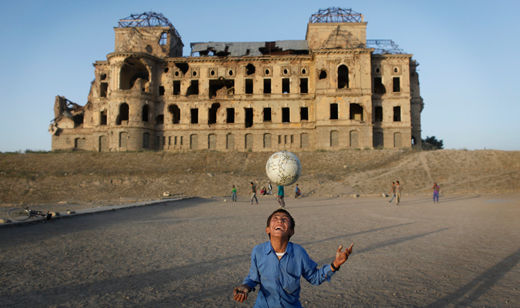
As the world awaits President Obama’s June 22 announcement about withdrawing U.S. troops from Afghanistan, an intense debate is taking place within the administration about how, and how quickly, to start the drawdown.
But developments at home and in Afghanistan point in one direction: the urgency of making a significant down payment on the troops’ safe return home. Opposition is escalating to a conflict that has already cost the lives of over 1,500 U.S. troops and countless civilians, and has a $100 billion-per-year price tag.
The weekend saw a diplomatic firestorm. Afghan President Hamid Karzai lashed out at the foreign troop presence in his country. As he confirmed for the first time long-persistent reports of Afghan and U.S. meetings with the Taliban, he declared, “The nations of the world which are here in our country are here for their own national interests. They are using our country.”
Departing U.S. Ambassador Karl Eikenberry slapped back, expressing anger that U.S. forces were being “compared to occupiers” and claiming the U.S. “has never sought to occupy any nation in the world.”
Karzai has become more and more outspoken with such denunciations. Late last month, after an airstrike killed 14 civilians including children, he warned that with more such incidents, foreign troops would be seen as “a force that is fighting against the people of Afghanistan.” “And in that case,” he said, “history shows what Afghans do with trespassers and with occupiers.”
Meanwhile, despite the presence of 140,000 foreign troops – 100,000 of them from the U.S. – the military situation remains highly unstable, with gains in one area offset by losses in others, and Afghan forces far from ready to take the lead.
While the U.S. military claims success for its counterinsurgency campaign in southern Afghanistan, it is careful to call the gains “fragile and reversible.”
Armed insurgents are able to mount attacks even in Kabul, the capital city, and incidents continue of Afghan soldiers and police turning on their mentors with deadly results.
At home, opposition to the war continues to grow. A CNN/Opinion Research poll earlier this month showed 62 percent of Americans opposing it, and nearly three-quarters wanting some or all troops withdrawn.
Following up the U.S. House of Representatives’ near-passage last month of a bipartisan amendment for a pull-out timetable and completion date, in mid-June a bipartisan group of 27 senators called on Obama to start a major pullout of troops. The group included 24 liberal and centrist Democrats – 10 of them committee chairs – along with two Republicans and one independent. Among them were Democratic Caucus leaders Dick Durbin, Ill. and Charles Schumer, N.Y., along with fellow Democrats Max Baucus, Mont. and Kent Conrad, N.D. Republican signers were Mike Lee, Utah and Rand Paul, Ky.
“We write to express our strong support for a shift in strategy and the beginning of a sizable and sustained reduction of U.S. military forces in Afghanistan, beginning in July 2011,” they said. “There are those who argue that rather than reduce our forces, we should maintain a significant number of troops in order to support a lengthy counterinsurgency and nation-building effort. This is misguided.”
Speculation is rampant about the size of the withdrawal Obama will announce. Predictions range from a Pentagon proposal of 5,000 to withdrawal of the 30,000 “surge” troops within a year.
But even the higher guesstimates are far too low for many. In a letter, U.S. Rep. Barbara Lee, D-Calif., last week said withdrawing even 30,000 would not be enough.
“A more ‘significant’ and reasonable goal would be the withdrawal of 50,000 combat troops,” she wrote. “Delaying a significant and sizable reduction of U.S. forces in Afghanistan would be unacceptable and would not reflect the will of the people.”
Reflecting the dire predicament of the nation’s cities after rampant federal and state funding cuts for human needs, the U.S. Conference of Mayors June 20 adopted a “Bring Our War Dollars Home” resolution calling for a quick end to the Iraq and Afghanistan wars and a shift of funds to domestic needs. Organizers said the conference had not urged an end to a military engagement since the Vietnam War.
So what would follow the exodus of foreign military forces from Afghanistan?
One thing everyone agrees on is the need for all-around support for the troops when they come home. This must include many-sided help for victims of post-traumatic stress disorder, as well as traumatic brain and other injuries. The Obama administration has significantly improved the treatment of veterans; they will need much more help in coming years.
As for Afghanistan itself, that part of the insurgency that primarily opposes the foreign troop presence is likely to fade significantly. Withdrawal of foreign troops will be essential to successful talks with the armed insurgency.
As conflict recedes, help in rebuilding a shattered economy, bringing displaced people home and helping them reconstruct their lives, and needed security assistance, will best come from international organizations including the United Nations.
Afghans themselves will have to curb the destructive power of warlords and corrupt political leaders, and decide how to rebuild their shattered land. In many places civil society is ready to take on those roles – to engage in real nation-building – as armed conflict recedes.
Photo: Afghan children play soccer in front of the war-damaged Darul Aman Palace in the suburbs of Kabul, Afghanistan, June 8. Gemunu Amarasinghe/AP









